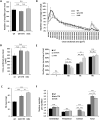Muscle regeneration affects Adeno Associated Virus 1 mediated transgene transcription
- PMID: 35690627
- PMCID: PMC9188557
- DOI: 10.1038/s41598-022-13405-9
Muscle regeneration affects Adeno Associated Virus 1 mediated transgene transcription
Abstract
Duchenne muscular dystrophy is a severe neuromuscular disease causing a progressive muscle wasting due to mutations in the DMD gene that lead to the absence of dystrophin protein. Adeno-associated virus (AAV)-based therapies aiming to restore dystrophin in muscles, by either exon skipping or microdystrophin expression, are very promising. However, the absence of dystrophin induces cellular perturbations that hinder AAV therapy efficiency. We focused here on the impact of the necrosis-regeneration process leading to nuclear centralization in myofiber, a common feature of human myopathies, on AAV transduction efficiency. We generated centronucleated myofibers by cardiotoxin injection in wild-type muscles prior to AAV injection. Intramuscular injections of AAV1 vectors show that transgene expression was drastically reduced in regenerated muscles, even when the AAV injection occurred 10 months post-regeneration. We show also that AAV genomes were not lost from cardiotoxin regenerated muscle and were properly localised in the myofiber nuclei but were less transcribed leading to muscle transduction defect. A similar defect was observed in muscles of the DMD mouse model mdx. Therefore, the regeneration process per se could participate to the AAV-mediated transduction defect observed in dystrophic muscles which may limit AAV-based therapies.
© 2022. The Author(s).
Conflict of interest statement
The authors declare no competing interests.
Figures





Similar articles
-
AAV genome loss from dystrophic mouse muscles during AAV-U7 snRNA-mediated exon-skipping therapy.Mol Ther. 2013 Aug;21(8):1551-8. doi: 10.1038/mt.2013.121. Epub 2013 Jun 11. Mol Ther. 2013. PMID: 23752313 Free PMC article.
-
Delivery of AAV2/9-microdystrophin genes incorporating helix 1 of the coiled-coil motif in the C-terminal domain of dystrophin improves muscle pathology and restores the level of α1-syntrophin and α-dystrobrevin in skeletal muscles of mdx mice.Hum Gene Ther. 2011 Nov;22(11):1379-88. doi: 10.1089/hum.2011.020. Epub 2011 May 25. Hum Gene Ther. 2011. PMID: 21453126 Free PMC article.
-
Assessment of Therapeutic Potential of a Dual AAV Approach for Duchenne Muscular Dystrophy.Int J Mol Sci. 2023 Jul 13;24(14):11421. doi: 10.3390/ijms241411421. Int J Mol Sci. 2023. PMID: 37511179 Free PMC article.
-
[Gene therapy for muscular dystrophy].No To Hattatsu. 2004 Mar;36(2):117-23. No To Hattatsu. 2004. PMID: 15031985 Review. Japanese.
-
Perspective on Adeno-Associated Virus Capsid Modification for Duchenne Muscular Dystrophy Gene Therapy.Hum Gene Ther. 2015 Dec;26(12):786-800. doi: 10.1089/hum.2015.107. Epub 2015 Oct 15. Hum Gene Ther. 2015. PMID: 26414293 Free PMC article. Review.
Cited by
-
Adeno-Associated Virus 8 and 9 Myofibre Type/Size Tropism Profiling Reveals Therapeutic Effect of Microdystrophin in Canines.J Cachexia Sarcopenia Muscle. 2025 Feb;16(1):e13681. doi: 10.1002/jcsm.13681. J Cachexia Sarcopenia Muscle. 2025. PMID: 39790021 Free PMC article.
-
Therapeutic approaches for Duchenne muscular dystrophy.Nat Rev Drug Discov. 2023 Nov;22(11):917-934. doi: 10.1038/s41573-023-00775-6. Epub 2023 Aug 31. Nat Rev Drug Discov. 2023. PMID: 37652974 Review.
-
Therapeutic Application and Structural Features of Adeno-Associated Virus Vector.Curr Issues Mol Biol. 2024 Aug 2;46(8):8464-8498. doi: 10.3390/cimb46080499. Curr Issues Mol Biol. 2024. PMID: 39194716 Free PMC article. Review.
-
IGF-1 Therapy Improves Muscle Size and Function in Experimental Peripheral Arterial Disease.JACC Basic Transl Sci. 2023 Mar 8;8(6):702-719. doi: 10.1016/j.jacbts.2022.12.006. eCollection 2023 Jun. JACC Basic Transl Sci. 2023. PMID: 37426532 Free PMC article.
-
The Role of Mitochondria in Mediation of Skeletal Muscle Repair.Muscles. 2023 Mar 24;2(2):119-163. doi: 10.3390/muscles2020011. Muscles. 2023. PMID: 40757564 Free PMC article. Review.
References
Publication types
MeSH terms
Substances
Supplementary concepts
LinkOut - more resources
Full Text Sources

